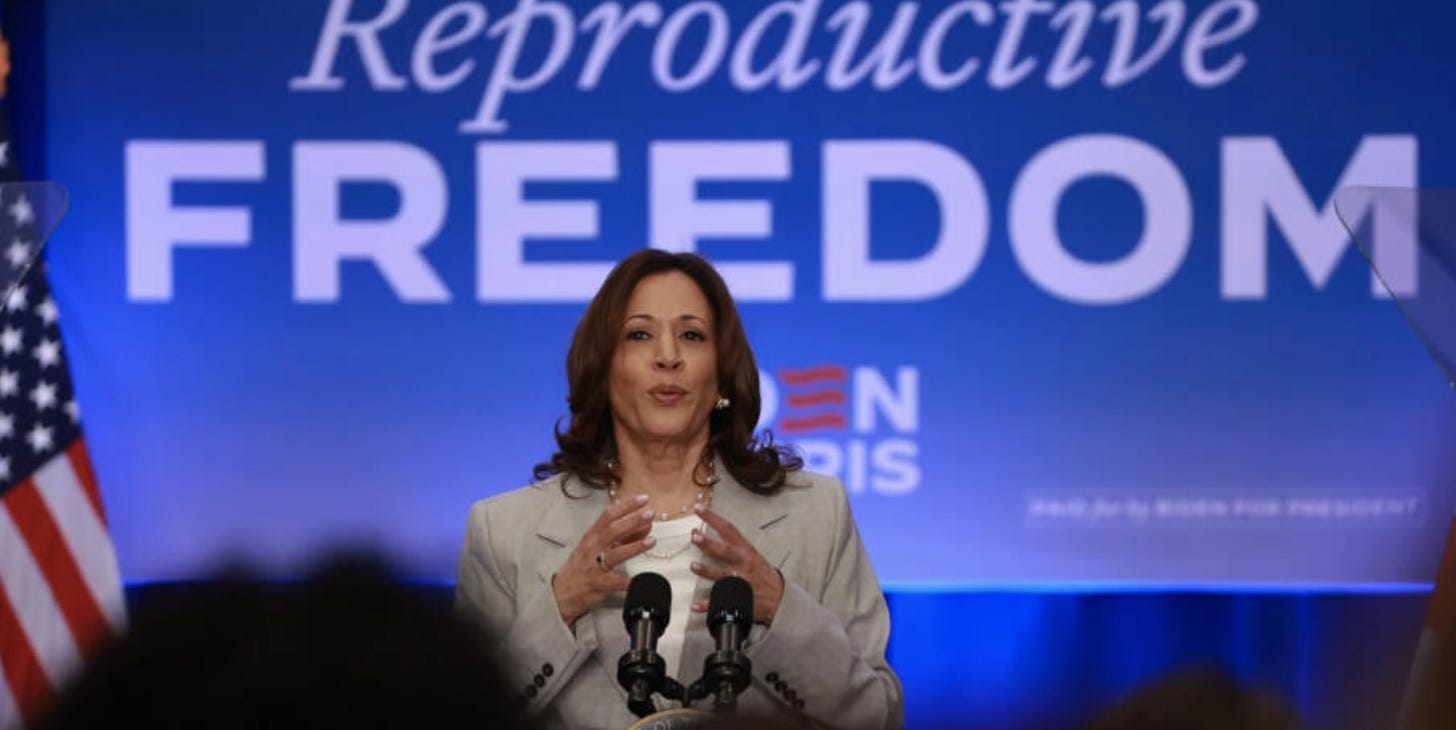What is the Vision of the Harris Campaign?
Interpreting what "Freedom" and "Not Going Back" mean
Kamala Harris has kickstarted her campaign with sharp political strategies, especially on social media. A press release under the heading “Statement on 78-Year Old Criminal’s Fox News Appearance” included the bullet point “Trump is old and quite weird?” Another noted, “JD Vance is weird.” So far, the strategy is working, allowing Harris to frame her opponents in a way that prior Democrats had not.
“Weird” might be effective political messaging, but it tells us little about what a Harris presidency would look like. A critique of Harris is that she lacks what former President George H.W. bush referred to as “the vision thing.” David Brooks gave her a C on vision, saying that she “hasn’t shown she has a coherent worldview — the way, say, Biden does — you need to be a good decision maker in the White House. Over the past few years, when Harris has been asked to articulate her overall philosophy, she often produces a meaningless word salad, ripe for ridicule.”
Brooks’ critique is both premature and backward looking. The DNC is still weeks away, and Brooks relies on the Harris 2020 campaign for his characterization. But as she has begun to build her campaign, both her stump speech and her first ad lay out a vision, one that is arguably more compelling than any Democrat in recent years, and harkens back to FDR.
Obama’s “HOPE” was inspiring, but vague. Biden’s “Build Back Better” was practical, but narrow. Both reflected their context. For Obama, it was the desire for unity and a better version of America after fissures of Bush and the Iraq War. For Biden, the need to recover from a cratered economy after the pandemic.
Harris’ vision is encapsulated by two interconnected themes thus far: “Freedom” and “We are not going back.” Together they offers a statement on what her Presidency will be about, and a contrast with her opponent. They declare that we are not going back to an America where government is deployed to restrict and control our freedom, nor an America where the federal government stands by and lets either states or unregulated markets restrict and control our freedom.
Her first campaign ad starts with Beyonce’s “Freedom” and Harris saying:
In this election, we each face a question: What kind of country do we want to live in? There are some people who think we should be a country of chaos, of fear, of hate. But us, we choose something different. We choose freedom.
The use of freedom has layers of meaning. It evokes the fact that Harris is the first Black woman running for president, the first woman Vice-President, and so touches on the expansion of rights, or basic freedoms, for both women and Black Americans.
It also reclaims the mantle of freedom from the populist, increasingly authoritarian, movement undergirding Trump’s rise. Republicans have claimed freedom as a defining value for decades. Harris is taking it back. The ability of Republicans to hold onto their brand has become harder to maintain as elements of the coalition veer toward fascist statements, pass laws that constrain individual choice, identity and rights, or oppose the results of democratic processes.
The Republican version of freedom sees government as an impediment, which President Reagan articulated as “man is not free unless government is limited.” In this vision, limited government expands economic freedom by letting Adam Smith’s invisible hand work its magic. A shift toward laissez-faire economics dominated much of the 1980s, 1990s, and well into President Obama’s presidency. It’s a view encapsulated in the corporate push to free itself of government regulations that have ensured everything from clean water (no rivers on fire!) to protections for people defrauded by for profit colleges.
This model of freedom via limited government evokes a classical liberal model that all have equal rights. It’s a view, however, that assumes everyone stands on a level playing field, with equal political power, and where no group unduly constrains the rights of others. That philosophy is encapsulated in Chief Justice Robert’s position on the Voting Rights Acts that presumes racism is dead and has no bearing on why states like North Carolina or Texas are explicitly reenacting the burdens they used during segregation to prevent Black people from voting. More broadly, the courts of have been more concerned with the freedom to discriminate consistent with a White Christian nationalist logic rather than freedom from discrimination.
Instead, Harris promotes a different vision of freedom, a version that evokes, but updates, Franklin Delano Roosevelt’s definition of freedom, where people are free from want and fear and have freedom of speech and religion. With Beyonce in the background, Harris calls for:
The freedom not just to get by, but to get ahead.
The freedom to be safe from gun violence.
The freedom to make decisions about your own body.
We choose a future where no child lives in poverty.
Where we can all afford health care.
We believe in the promise of America and we are ready to fight for it.
This isn’t just a laundry list of policy goals. It’s a coherent vision of what government should, and should not, do. We need an active government to be free of fear, to regulate the guns that unravelling our social fabric and killing our children. We need an active government to ensure freedom from want, so that children don’t grow up poor in the wealthiest country in the world or are unable to afford basic health care. And, of course, it encapsulates the expansions of women’s rights, including new freedoms like right to control our own bodies.
When FDR made his Four Freedoms speech, the threat to democracy was external, with the rise of fascism in Europe. Now, the threat to democracy is internal, it’s coming from inside the house. Freedom from fear, for many, is a fear about whether they can control their bodies and identity. Freedom of speech means whether people can teach or learn about American history. Freedom of religion means the right to practice any religion, not just Christianity.
Harris also evokes the threats to basic economic rights, including Social Security and Medicare, what are core New Deal programs. She warns that undermining these programs won’t lead to “prosperity”, but rather “inequity and economic injustice.” Economic rights are tied to freedom.
In her stump speech, a key line is that “we’re not going back.” Audiences have responded by chanting “not going back” in response. The line resonates, and Harris has used it in another early ad. The obvious meaning is that we’re not going back to another Trump presidency. But it has a deeper meaning. As Harris argues in her stump speech:
Donald Trump wants to take our country backwards, to a time before many of our fellow Americans had full freedoms and rights. But we believe in a brighter future that makes room for all Americans.
“Not going back” evokes both a future orientation and a rejection of the selective and rose-tinted nostalgia of Make America Great Again. Populists like to evoke an idealized alternative to the threats of modernity. (The motto of Brexit – Take Back Control – similarly evoked a golden past). Left unsaid is that this idealized past relied upon a social hierarchy, defined by race and gender. This is the past that Harris, and her supporters, are rejecting.
Basic freedoms and rights that have expanded over the past 60 years are under attack. The loss of abortion rights, and more broadly threats to bodily autonomy, has been at the top of voters’ minds. As VP, this was a topic where Harris was very effective.
Perhaps the core of the call that ‘we’re not going back’ is that we’re not relinquishing the broader project of democracy. Harris is tapping a fear rooted in a growing threat to that project. It’s not just Trump trying to overthrow an election, or effectively end them altogether. It’s the everyday freedoms that are fundamental to democracy that are increasingly threatened. Educators face an array of restrictions over what they’re allowed to teach, especially about the enslavement of Black Americans and subsequent segregation and ongoing discrimination. The rights of LGBTQ persons, ranging from the right to marry, to the right to control their bodies is also threatened. Librarians risk prosecution for letting people read books deemed ‘inappropriate.’ And Christian Nationalism, including its patriarchal ideologies about the place of women, is prominent in the Trump world, as best espoused by his running mate complaining about “childless cat ladies.” The only analogous historical period where we faced such a significant retrenchment of basic rights was Reconstruction.
As the campaign evolves, these themes may change. The Democratic National Convention will be another chance for Harris to redefine her vision. But it is encouraging that Harris is, in fact, willing to articulate the meaning of a Harris presidency in such broad terms so quickly.






Excellent essay and I liked the way you discussed freedom and "not going back" as being connected and important. Being 72 years old I have never seen this level of excitement coupled with action in any Presidential election. I'll also say that I'm tired of having to fight the same social and/or political battles over and over again, but that's the way the process works. We have to be certain to keep this momentum going.
100%. I like the formulation of "freedom from, freedom to, freedom of" because as Professor Herd alludes to, we are not all at the same place with regard to freedom.
As charismatic and eloquent as President Obama is, his vision was and remains conservative. Vice-President Harris has a large, expansive vision and is inviting us to join as we are and work together for change and making things better. That vision is being shared fully, simply, and persuasively now in ways it wasn't previously. The Zoom calls, the fundraising, and the number of volunteers suggest it's working.